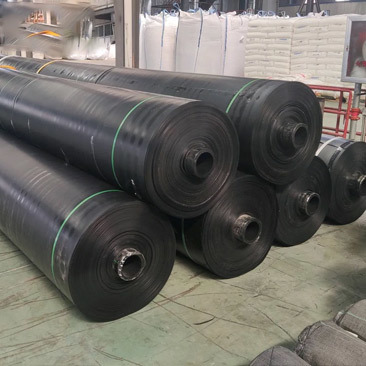How Geomembrane Material Enhances Site Safety and Durability
Release time:
2025-10-02
How Geomembrane Material Enhances Site Safety and Durability Table of Contents 1. Introduction to Geomembrane Materials 2. What is Geomembrane? 3. Key Benefits of Using Geomembrane 4. Applications of Geomembrane in Construction 5. Enhancing Site Safety with Geomembrane 6. Improving Durability with Geomembrane 7. Best Installation Techniques for Geomembrane 8. Successful Case Studies Using Geomemb
How Geomembrane Material Enhances Site Safety and Durability
Table of Contents
- 1. Introduction to Geomembrane Materials
- 2. What is Geomembrane?
- 3. Key Benefits of Using Geomembrane
- 4. Applications of Geomembrane in Construction
- 5. Enhancing Site Safety with Geomembrane
- 6. Improving Durability with Geomembrane
- 7. Best Installation Techniques for Geomembrane
- 8. Successful Case Studies Using Geomembrane
- 9. Frequently Asked Questions
- 10. Conclusion
1. Introduction to Geomembrane Materials
In the ever-evolving world of construction and site management, ensuring safety and durability is paramount. **Geomembrane materials** have emerged as a critical component in enhancing these aspects, providing robust solutions for various applications. These synthetic membranes are primarily used for containment and separation purposes, making them invaluable in the construction industry.
2. What is Geomembrane?
A **geomembrane** is a thin, flexible membrane liner or barrier made from polymer materials. Its primary function is to prevent the migration of liquids or gases in a variety of environmental applications. Typically used in landfill lining, waste containment, and water reservoir applications, geomembranes come in various types, including high-density polyethylene (HDPE), low-density polyethylene (LDPE), and polypropylene (PP).
3. Key Benefits of Using Geomembrane
Understanding the benefits of geomembrane materials can help stakeholders make informed decisions regarding their use in construction. Here are some of the key advantages:
3.1. Superior Containment Properties
**Geomembranes** offer excellent barriers against liquids and gases, significantly reducing contamination risks in sensitive environments.
3.2. Enhanced Durability
These materials are engineered to withstand harsh environmental conditions, including UV exposure, extreme temperatures, and chemical attacks, ensuring long-term performance.
3.3. Cost-Effectiveness
While the initial investment might seem significant, the cost-saving potential associated with reduced remediation and maintenance efforts cannot be overlooked.
3.4. Eco-Friendly Solutions
Many geomembranes are now manufactured from recycled materials, making them a more sustainable choice in construction practices.
3.5. Versatility
Geomembranes can be used in a variety of applications, from mining to agriculture, showcasing their adaptability across different sectors.
4. Applications of Geomembrane in Construction
The applications of geomembrane materials are extensive, addressing various construction challenges. Here are some prominent applications:
4.1. Landfill and Waste Management
One of the most common uses of geomembranes is in landfill lining and waste containment systems. They prevent leachate from contaminating surrounding soil and groundwater.
4.2. Water Reservoirs and Dams
In water conservation efforts, geomembranes are utilized to line reservoirs and dams, preventing water loss due to seepage.
4.3. Mining Operations
In mining, geomembranes are employed to line tailings ponds, ensuring that toxic materials do not escape into the environment.
4.4. Agricultural Uses
Geomembranes can also be used in agricultural applications, such as pond liners and irrigation systems, enhancing water retention and reducing evaporation.
4.5. Construction Sites
At construction sites, geomembranes are used for erosion control, sediment management, and as barriers against potential contaminants.
5. Enhancing Site Safety with Geomembrane
Safety is a critical concern in construction. Geomembrane materials enhance site safety in numerous ways.
5.1. Hazardous Material Containment
In scenarios where hazardous materials are present, geomembranes act as a reliable containment solution, preventing leakage and potential health risks.
5.2. Erosion Control
By stabilizing soil and preventing erosion, geomembranes contribute to a safer construction environment, reducing the risk of landslides and other geotechnical failures.
5.3. Reduced Environmental Impact
The use of geomembranes minimizes the ecological footprint of construction projects, aligning with environmental regulations and promoting sustainability.
6. Improving Durability with Geomembrane
The durability of construction materials is essential for the longevity of any project. Geomembranes significantly improve durability through:
6.1. Resistance to Environmental Factors
Geomembranes are designed to resist UV radiation, temperature fluctuations, and chemical exposure, ensuring they remain intact over extended periods.
6.2. Long Lifespan
The longevity of geomembranes reduces the need for frequent replacements, which can be both time-consuming and costly.
6.3. Minimal Maintenance Requirements
Once installed, geomembranes require minimal maintenance, allowing for a more efficient project lifecycle.
7. Best Installation Techniques for Geomembrane
Proper installation is crucial to maximize the benefits of geomembranes. Here are some best practices:
7.1. Site Preparation
Before installation, ensure the site is clean and free of sharp objects that could damage the geomembrane.
7.2. Seam Welding
Utilize high-quality seam welding techniques to ensure that joints are secure and leak-proof. Overlapping seams should be minimized to ensure integrity.
7.3. Testing for Leaks
Conduct appropriate testing, such as vacuum testing, to verify the integrity of the geomembrane installation.
7.4. Regular Inspections
Implement a routine inspection schedule post-installation to identify any potential issues early.
8. Successful Case Studies Using Geomembrane
Examining real-world applications can provide valuable insights into the effectiveness of geomembranes.
8.1. Case Study 1: Landfill Development
A municipal landfill project utilized geomembranes to prevent leachate from contaminating local water supplies. The project reported zero leaks during its operational phase.
8.2. Case Study 2: Agricultural Water Management
An agricultural project adopted geomembranes for pond liners, resulting in a 30% increase in water retention and reduced evaporation rates.
9. Frequently Asked Questions
9.1. What types of geomembranes are available?
There are several types, including HDPE, LDPE, PVC, and PP geomembranes, each suited for specific applications.
9.2. How long does a geomembrane last?
With proper installation and maintenance, geomembranes can last over 30 years.
9.3. Are geomembranes environmentally friendly?
Many geomembranes are manufactured from recycled materials, contributing to sustainable practices.
9.4. Can geomembranes be repaired?
Yes, geomembranes can be repaired using patching techniques or additional welding.
9.5. What are the costs associated with geomembrane installation?
Costs can vary based on material type, project scale, and installation complexity. It's essential to consult with suppliers for accurate estimates.
10. Conclusion
In conclusion, **geomembrane materials** play a vital role in enhancing site safety and durability within the construction industry. Their superior containment properties, versatility, and environmental benefits make them a preferred choice for various applications. By understanding the advantages and best practices for using geomembranes, stakeholders can improve construction processes, ensuring safer and more durable outcomes for projects. Investing in geomembranes is not just a step towards compliance; it is a commitment to quality and sustainability in construction.






